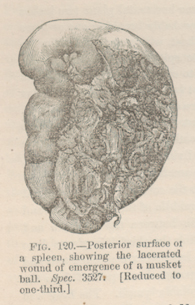Title: K——, Martin
Source text: The Medical and Surgical History of the War of the Rebellion. (1861-65.), Part 2, Volume 2 (Washington, DC: Government Printing Office, 1876), 156.
Civil War Washington ID: med.d2e31554
TEI/XML: med.d2e31554.xml
CASE 499.—Lieutenant Martin K——, Co. A, 69th New York, aged 25 years, was wounded at Spottsylvania, May 12, 1864. He was conveyed by ambulance to Belle Plain, and thence by steamer to Washington, where he arrived thirteen days after the reception of the injury, and was admitted into Douglas Hospital. He died on May 26, 1864. At the autopsy the ball was found to have entered the left side one inch outside of a line falling from the nipple over the eighth rib, to have penetrated the diaphragm in two places, lacerated the spleen (FIG. 120) and left kidney, fractured the ninth and tenth ribs, and lodged in the soft parts beneath the skin, from which place it had been removed on the field. The symptoms previous to death were those due to acute traumatic pleuritis, and two quarts of bloody serum were found in the left thoracic cavity. The pleura was covered thickly with a layer of pink lymph, and the lung was compressed. The occlusion of the two openings in the inferior portion of the cavity and the retention of so large a quantity of fluid is remarkable, and indicates the necessity for ascertaining that free exits exist for such effusions. A quantity of blood was found effused into the abdominal cavity. It is remarkable that life should continue so long with such extensive injuries. Another observation worthy of notice was, that the upper portion of the left thoracic cavity was sonorous on percussion, a condition due to the compressed air in the air vesicles, or to the presence of some air in the thoracic cavity compressed by the increasing effusion. Upon microscopical examination, a transverse section exhibits no modifications of the normal structure except those obviously due to congestion. The Malpighian bodies are natural in number and distribution; the veins and capillaries are enlarged.
